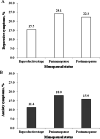Prevalence and risk factors for depressive and anxiety symptoms in middle-aged Chinese women: a community-based cross-sectional study
- PMID: 35906641
- PMCID: PMC9338469
- DOI: 10.1186/s12905-022-01908-6
Prevalence and risk factors for depressive and anxiety symptoms in middle-aged Chinese women: a community-based cross-sectional study
Abstract
Background: Depression and anxiety have become main public health concerns globally. However, risk factors for depression and anxiety remain unclear. This study was to examine the prevalence and risk factors of depressive and anxiety symptoms in middle-aged Chinese women.
Methods: This cross-sectional study, conducted in 2018, included 7,727 women aged 40-60 years from the eastern, central and western regions of China. Depressive and anxiety symptoms were determined by the Patient Health Questionnaire-9 and the Generalized Anxiety Disorders-7, respectively. Logistic regression models were used to estimate odds ratios (ORs) for depressive and anxiety symptoms in relation to sociodemographic, lifestyle and menopausal factors.
Results: Among all participants, 19.5% (1 422/7 275) and 14.2% (1 035/7 275) of participants experienced depressive and anxiety symptoms, respectively. The multivariable logistic regression models showed that age, household income, regular physical activity, chronic diseases, menopausal status, vasomotor symptoms, somatic symptoms and urogenital symptoms were associated with depressive symptoms, while place of residence, regular physical activity, chronic diseases, vasomotor, somatic and urogenital symptoms were associated with anxiety symptoms.
Conclusion: Depressive and anxiety symptoms were common among middle-aged Chinese women, and certain sociodemographic, lifestyle and menopausal symptoms have an important impact on the risk of depressive and anxiety symptoms.
Keywords: Anxiety symptoms; Depressive symptoms; Menopause; Perimenopause; Postmenopause; Risk factors.
© 2022. The Author(s).
Conflict of interest statement
The authors declare that there are no competing interests.
Figures
Similar articles
-
Association of menopausal status and symptoms with depressive symptoms in middle-aged Chinese women.Climacteric. 2022 Oct;25(5):453-459. doi: 10.1080/13697137.2021.1998435. Epub 2021 Nov 16. Climacteric. 2022. PMID: 34783275
-
Insomnia symptoms in relation to menopause among middle-aged Chinese women: Findings from a longitudinal cohort study.Maturitas. 2020 Nov;141:1-8. doi: 10.1016/j.maturitas.2020.06.010. Epub 2020 Jun 15. Maturitas. 2020. PMID: 33036697
-
Depressive symptoms in Taiwanese women during the peri- and post-menopause years: associations with demographic, health, and psychosocial characteristics.Maturitas. 2013 Aug;75(4):355-60. doi: 10.1016/j.maturitas.2013.04.021. Epub 2013 May 29. Maturitas. 2013. PMID: 23726260
-
Psychological resilience during the perimenopause.Maturitas. 2020 Jan;131:48-56. doi: 10.1016/j.maturitas.2019.10.015. Epub 2019 Nov 5. Maturitas. 2020. PMID: 31787147 Review.
-
Depression during the perimenopause: A meta-analysis.J Affect Disord. 2016 Dec;206:174-180. doi: 10.1016/j.jad.2016.07.040. Epub 2016 Jul 22. J Affect Disord. 2016. PMID: 27475888 Review.
Cited by
-
Associations between reproductive health factors and sociodemographic characteristics and the severity of moderate to severe postmenopausal depression: a secondary analysis of randomized controlled trial data.Menopause. 2025 Jul 1;32(7):621-629. doi: 10.1097/GME.0000000000002543. Menopause. 2025. PMID: 40460394 Free PMC article. Clinical Trial.
-
The relationship between depression and sexual satisfaction: An equation model analysis.J Educ Health Promot. 2023 Nov 27;12:419. doi: 10.4103/jehp.jehp_1609_22. eCollection 2023. J Educ Health Promot. 2023. PMID: 38333158 Free PMC article.
-
A meta-analysis on the incidence rate of depression in Chinese menopausal women.BMC Psychiatry. 2025 Feb 19;25(1):154. doi: 10.1186/s12888-025-06603-y. BMC Psychiatry. 2025. PMID: 39972281 Free PMC article.
-
Effects of pain, hospitalization, and medication on depressive symptom in Syrian patients with chronic diseases.Sci Rep. 2024 Sep 5;14(1):20751. doi: 10.1038/s41598-024-71543-8. Sci Rep. 2024. PMID: 39237574 Free PMC article.
-
Effects of mind-body exercise on perimenopausal and postmenopausal women: a systematic review and meta-analysis.Menopause. 2024 May 1;31(5):457-467. doi: 10.1097/GME.0000000000002336. Menopause. 2024. PMID: 38669625 Free PMC article.
References
MeSH terms
LinkOut - more resources
Full Text Sources
Medical


